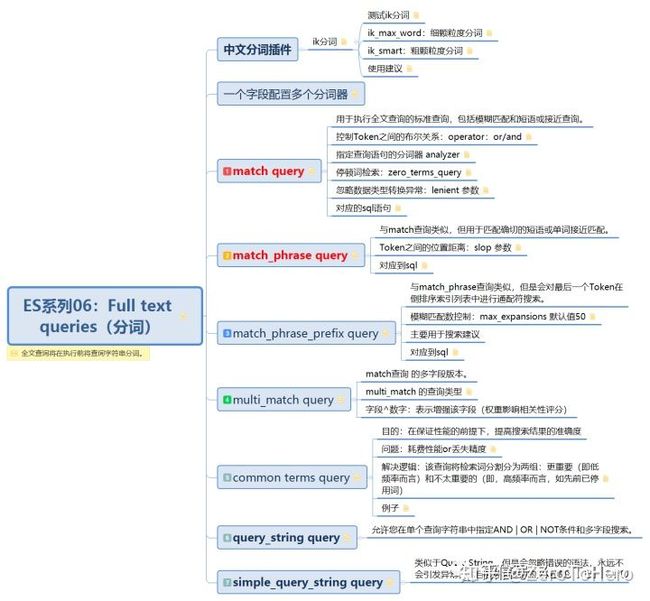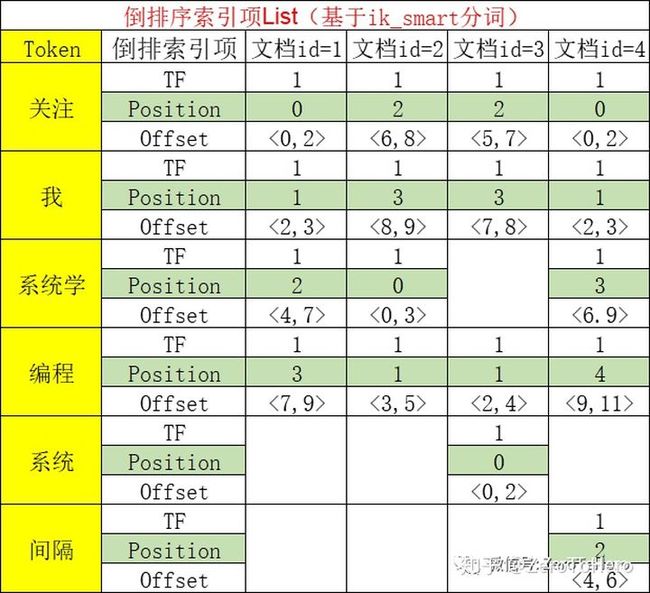ES系列07:match_phrase与match_phrase_prefix query
昨天为大家介绍了 ES系列06:ik分词+Full text queries 之match query。今天TeHero为大家分享 Full text queries 的 match_phrase query 和match_phrase_prefix query, 同时从倒排序索引原理入手,将DSL语句转化为sql语句,方便大家理解学习。【关注公众号: ZeroTeHero,系统学习ES】
ps:上图的xmind文件,公众号里 可免费获取!
一、在开始之前,完成数据准备:
# 创建映射
PUT /tehero_index
{
"settings": {
"index": {
"number_of_shards": 1,
"number_of_replicas": 1
}
},
"mappings": {
"_doc": {
"dynamic": false,
"properties": {
"id": {
"type": "integer"
},
"content": {
"type": "keyword",
"fields": {
"ik_max_analyzer": {
"type": "text",
"analyzer": "ik_max_word",
"search_analyzer": "ik_max_word"
},
"ik_smart_analyzer": {
"type": "text",
"analyzer": "ik_smart"
}
}
},
"name":{
"type":"text"
},
"createAt": {
"type": "date"
}
}
}
}
}
# 导入测试数据
POST _bulk
{ "index" : { "_index" : "tehero_index", "_type" : "_doc", "_id" : "1" } }
{ "id" : 1,"content":"关注我,系统学编程" }
{ "index" : { "_index" : "tehero_index", "_type" : "_doc", "_id" : "2" } }
{ "id" : 2,"content":"系统学编程,关注我" }
{ "index" : { "_index" : "tehero_index", "_type" : "_doc", "_id" : "3" } }
{ "id" : 3,"content":"系统编程,关注我" }
{ "index" : { "_index" : "tehero_index", "_type" : "_doc", "_id" : "4" } }
{ "id" : 4,"content":"关注我,间隔系统学编程" }二、根据ik_smart分词和content字段建立倒排序索引
原始数据:
{ "id" : 1,"content":"关注我,系统学编程" }
{ "id" : 2,"content":"系统学编程,关注我" }
{ "id" : 3,"content":"系统编程,关注我" }
{ "id" : 4,"content":"关注我,间隔系统学编程" }
ps:如果看不懂上图,请先阅读学习:ElasticSearch系列05:倒排序索引与分词Analysis
三、match query 对应到mysql
昨天有小伙伴反馈说,match query 的实例写得太枯燥,建议和mysql对比讲解,今天它来了!
# DSL 语句
GET /tehero_index/_doc/_search
{
"query":{
"match":{
"content.ik_smart_analyzer":"系统编程"
}
}
}DSL执行步骤分析:
- 1)检索词“系统编程”被ik_smart分词器分词为两个Token【系统】【编程】;
- 2)将这两个Token在【倒排索引】中,针对Token字段进行检索,等价于sql:【where Token = 系统 or Token = 编程】;
- 3)对照图【数据的倒排序索引】,可见,该DSL能检索到所有文档,文档3的评分最高(因为它包含两个Token),其他3个文档评分相同。
有了对应到mysql 的例子,我想大家对match query 这个查询语句,就应该有一个很好的理解。那么接下来,开始学习今天的新知识: match_phrase query 和match_phrase_prefix query
四、match_phrase query
match_phrase查询分 析文本并根据分析的文本创建一个短语查询。match_phrase 会将检索关键词分词。match_phrase的分词结果必 须在被检索字段的分词中都包含,而且 顺序必须相同,而且 默认必须都是连续的。
简单看个例子,与match query 对比下,就很好理解了:
使用 match_phrase 查询:
# 使用match_phrase查询,ik_smart分词
GET /tehero_index/_doc/_search
{
"query": {
"match_phrase": {
"content.ik_smart_analyzer": {
"query": "关注我,系统学"
}
}
}
}
# 结果:只有文档1
{
"took": 1,
"timed_out": false,
"_shards": {
"total": 1,
"successful": 1,
"skipped": 0,
"failed": 0
},
"hits": {
"total": 1,
"max_score": 0.7370664,
"hits": [
{
"_index": "tehero_index",
"_type": "_doc",
"_id": "1",
"_score": 0.7370664,
"_source": {
"id": 1,
"content": "关注我,系统学编程"
}
}
]
}
}使用 match 查询:
# 使用match查询,ik_smart分词
GET /tehero_index/_doc/_search
{
"query": {
"match": {
"content.ik_smart_analyzer": {
"query": "关注我,系统学"
}
}
}
}
# 可以查询出所有结果分析:上面的例子使用的 分词器是ik_smart,所以 检索词“关注我,系统学”会被分词为3个Token【关注、我、系统学】;而文档1、文档2和文档4 的content被分词后 都包含这3个关键词,但是 只有文档1的Token的顺序和检索词一致,且连续。所以使用 match_phrase 查询 只能查询到文档1(ps:文档2 Token顺序不一致;文档4 Token不连续;文档3 Token没有完全包含)。 使用 match查询可以查询到所有文档,是因为所有文档 都有【关注、我】这两个Token。
- 4.1 match_phrase 核心参数:slop 参数-Token之间的位置距离容差值
# 将上面的 match_phrase 查询新增一个 slop参数
GET /tehero_index/_doc/_search
{
"query": {
"match_phrase": {
"content.ik_smart_analyzer": {
"query": "关注我,系统学",
"slop":1
}
}
}
}
# 结果:文档1和文档4都被检索出来分析:使用 analyze 接口 分析下文档4的Token
# 文档4 content 的分词
GET /_analyze
{
"text": ["关注我,间隔系统学编程"],
"analyzer": "ik_smart"
}
# 结果
{
"tokens": [
{
"token": "关注",
"start_offset": 0,
"end_offset": 2,
"type": "CN_WORD",
"position": 0
},
{
"token": "我",
"start_offset": 2,
"end_offset": 3,
"type": "CN_CHAR",
"position": 1
},
{
"token": "间隔",
"start_offset": 4,
"end_offset": 6,
"type": "CN_WORD",
"position": 2
},
{
"token": "系统学",
"start_offset": 6,
"end_offset": 9,
"type": "CN_WORD",
"position": 3
},
{
"token": "编程",
"start_offset": 9,
"end_offset": 11,
"type": "CN_WORD",
"position": 4
}
]
}通过分词测试,发现Token【我】与【系统学】的 position差值为1(等于slop的值 ), 所以文档4也被检索出来了。
ps:如果没看明白,那就来看下match_phrase query对应到mysql是怎样的吧!
- 4.2match_phrase query对应到mysql
# DSL语句
GET /tehero_index/_doc/_search
{
"query":{
"match_phrase":{
"content.ik_smart_analyzer":"系统编程"
}
}
}DSL执行步骤分析:
- 1)检索词“系统编程”被分词为两个Token【系统,Position=0】【编程,Position=1】;
- 2)倒排索引检索时,等价于sql:【where Token = 系统 and 系统_Position=0 and Token = 编程 and 编程_Position=1】;
- 3)对照图【数据的倒排序索引】,只有文档3满足条件,所以该DSL语句只能查询到文档3。
五、match_phrase_prefix query
与match_phrase查询类似,但是 会对最后一个Token在倒排序索引列表中进行通配符搜索。Token的模糊匹配数控制: max_expansions 默认值为50。我们使用 content.ik_smart_analyzer 这个字段中的 【系统学】(文档1、2、4 包含)和 【系统】(文档3包含)这 两个Token来讲解match_phraseprefix 的用法:(因为 使用的是ik_smart分词器,所以【系统学】就只能被分词为一个Token)
# 1、先使用match_phrase查询,没有结果
GET tehero_index/_doc/_search
{
"query": {
"match_phrase": {
"content.ik_smart_analyzer": {
"query": "系"
}
}
}
}
# 2、使用match_phrase_prefix查询, "max_expansions": 1,得到文档3
GET tehero_index/_doc/_search
{
"query": {
"match_phrase_prefix": {
"content.ik_smart_analyzer": {
"query": "系",
"max_expansions": 1
}
}
}
}
# 3、使用match_phrase_prefix查询, "max_expansions": 2,得到所有文档
GET tehero_index/_doc/_search
{
"query": {
"match_phrase_prefix": {
"content.ik_smart_analyzer": {
"query": "系",
"max_expansions": 2
}
}
}
}结果分析:【语句1】查不到结果,是因为 根据ik_smart分词器生成的倒排序索引中,所有文档中都 不包含Token【系】;【语句2】查询到文档3,是因为 文档3包含Token【系统】,同时 "max_expansions": 1,所以 检索关键词【系】+ 1个通配符匹配,就可以匹配到 一个Token【系统】;【语句3】查询到所有文档,是因为"max_expansions": 2,所以 检索关键词【系】+ 2个通配符匹配,就可以匹配到 两个Token【系统、系统学】,所以就可以查询到所有。回忆下,之前所讲的es倒排序索引原理: 先分词创建倒排序索引,再检索倒排序索引得到文档,就很好理解了 。
注意:"max_expansions"的值最小为1,哪怕你设置为0,依然会 + 1个通配符匹配;所以,尽量不要用该语句,因为,最后一个Token始终要去扫描大量的索引,性能可能会很差。
- 5.1 match_phrase_prefix query 对应到mysql
GET tehero_index/_doc/_search
{
"query": {
"match_phrase_prefix": {
"content.ik_smart_analyzer": {
"query": "系",
"max_expansions": 1
}
}
}
}DSL执行步骤分析:
- 1)检索词“系”被分词为一个个Token【系】+ 1个通配符;
- 2)倒排索引检索时,等价于sql:【where Token = 系 or Token like “系_”】;
- 3)对照图【数据的倒排序索引】,只有文档3满足条件包含Token【系统】,所以该DSL语句只能查询到文档3。
六、总结
到此,我们已经学习了 Full text queries最常用的3种查询:
1)match query:用于执行全文查询的标准查询,包括 模糊匹配和短语或接近查询。重要参数:控制Token之间的布尔关系:operator:or/and
2)match_phrase query:与match查询类似, 但用于匹配确切的短语或单词接近匹配。重要参数:Token之间的位置距离:slop 参数
3)match_phrase_prefix query:与match_phrase查询类似,但是会 对最后一个Token在倒排序索引列表中进行通配符搜索。重要参数:模糊匹配数控制:max_expansions 默认值50,最小值为1
ps:如果对你有用,在看+收藏+分享 就是对TeHero最大的鼓励。
下期预告:Full text queries 剩余的4种查询【关注公众号: ZeroTeHero,系统学习ES】
ElasticSearch系列01:如何系统学习ESmp.weixin.qq.com
ElasticSearch系列03:ES的数据类型mp.weixin.qq.com
ElasticSearch系列05:倒排序索引与分词Analysismp.weixin.qq.com
ES系列06:ik分词+Full text queries 之match querymp.weixin.qq.com


